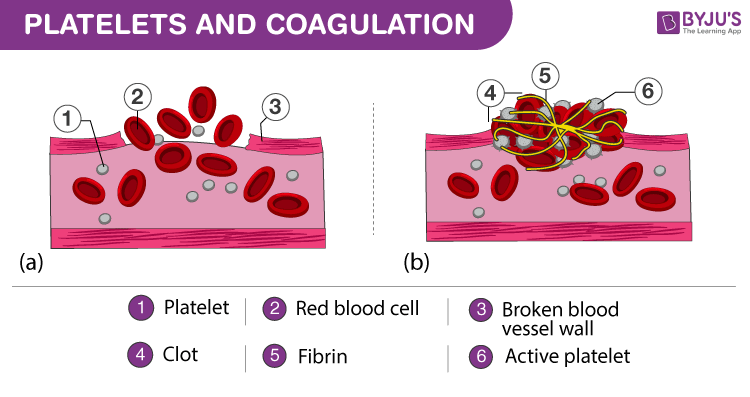The human body consists of various organ systems and mechanisms to regulate different functions. Our body starts bleeding when cut or injured, but the blood clots and bleeding cease after some time.
Why does this happen? What is the mechanism behind blood clots?
Yes, it is mainly because of the clotting factors released by the blood platelets.
Blood Platelets

Blood platelets are also called thrombocytes.
Blood platelets are tiny blood cells that form clots over the injury thereby stopping the bleeding. These blood cells are produced in the bone marrow and appear as a small, disc-shaped, colourless fragment without a nucleus.
What is a Healthy Platelet Count?
A healthy adult human body contains approximately 1.3 gallons of blood. The total platelet count usually varies between 150,000 to 450,000 per microliter of blood and a single drop of blood has lakhs of blood platelets.
Blood is a body’s fluid connective tissue, which circulates throughout the body under high pressure and helps maintain hemostasis. Constant blood loss can result in death, and hence, we need a mechanism to counteract blood loss.
The mechanism which helps the body to prevent blood loss is called hemostasis. For hemostasis, the body needs both platelets and a coagulation system. Platelets are specialised blood cells, which help in the healing process. Under normal conditions, the blood is fluid in nature but hemostasis leads to blood clots’ solidification.
Hemostasis
The physiological defensive reaction towards damage, cut, or an injury is termed hemostasis. This physiological process helps by sealing the blood vessels and thus helps in healing. Blood platelets, blood proteins and endothelium of blood vessels are mainly responsible for hemostasis.
The process of Hemostasis follows this series of steps:
- Changes in blood vessel cells
- Clot-forming process
- Formation of the platelet plugs.
Hemostasis takes place in two stages:
Primary hemostasis
The primary hemostasis serves immediately to stop the initial bleeding after an injury. A platelet plug is formed during primary hemostasis as the bleeding is reduced or controlled by narrowing the blood vessels. Later the thrombin signals for the assembly of platelets and thus creates a loose platelet plug.
Secondary hemostasis
The secondary hemostasis involves the action of blood proteins or plasma proteins, and other factors, which are responsible for:
- Controlling the bleeding.
- A sequence to strengthen the platelet plug.
- To mark or to identify the origin of the healing process.
Coagulation

Coagulation is also known as clotting.
Coagulation is a physiological process through which a blood clot is formed. The process of blood coagulation leads to the prevention of bleeding.
Explore more: Blood Coagulation
This article concludes with a short introduction to blood platelets.
Stay tuned to BYJU’S Biology and learn more in detail about blood platelets, their structure, functions, significance and their disorders.